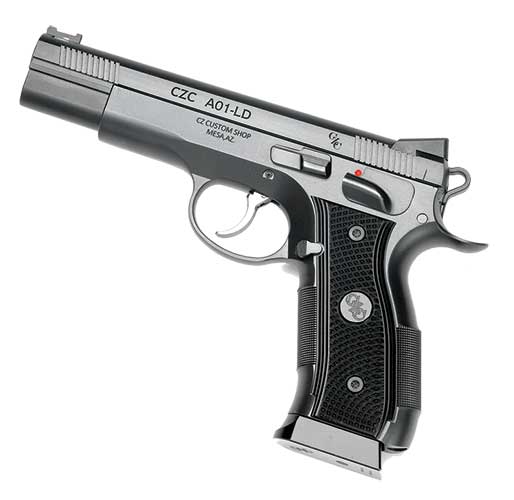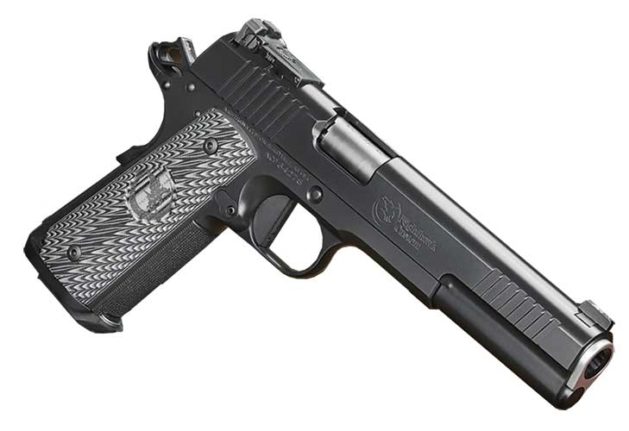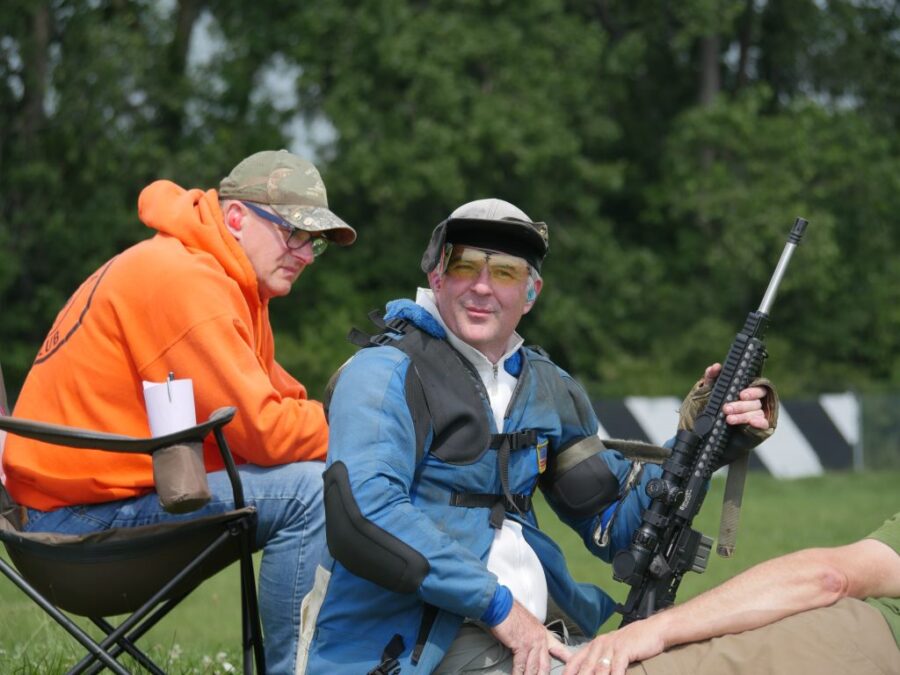“You have to be patient. It’s word of mouth,” Ready advised. “You have to realize it’s going to take a few years to get there.”
In pre-COVID days, Hartman boosted his customer base by participating in online forums and websites catering to 1911 collectors and enthusiasts. He also uses his inventory to help customers work their way up to the pricier guns. He sees it as a process.
They might start with a GLOCK and then come across nicer options during research and comparisons. They start looking at 1911s. Maybe they’ll start with a Springfield Armory Range Officer and then move on to a Dan Wesson.
“From there, it’s not much of a jump to the $2,000 mark,” Hartman said. “Getting them over the $1,000 mark — that’s the mental hurdle.”
Competition shooters also offer a potential avenue.
The High-End Firearm Spectrum
Stepping Into The Upper End Of The Market
Late December, the folks at Centennial Gun Club decided to take a chance ordering a handful of pricey Walther special-edition handguns.
The Q5 Match SF comes in a range of configurations — with features including engravings, grip checkering, enhanced triggers and improved finishes — geared toward collectors and those with more than a little cash to spend. The “cheapest” of these guns tops the $2,500 mark.
“We figured we’d give it a shot. Turns out there are still people who really like the Walther Q5,” recalled Joey Mizufuka, sales manager at the Centennial, Colo., shop. “We quickly sold the first two we got in just a couple of weeks.”
You may be looking around your shop wondering where you’d put a half-dozen handguns with $2,500+ price tags. If so, which guns would you stock? And would your customers even be interested in them? Interested enough to pay for them, that is.
Stepping into the realm of higher-end firearms isn’t for everyone. It’s an easy way to invest a lot of capital in slow-moving inventory. But in the right circumstances, it can set your business apart.
Making The Leap
When Scott Ready took ownership of Country Attic Treasures, he decided early on he wasn’t going to focus on the same inventory carried by big-box retailers, figuring they’d have the advantage of bulk purchasing power. He wanted something to help his shop stand out.
“In a market flush with gun stores, in general, it’s a way to become unique and reach an underserved market,” Ready said.
Today, his South Lebanon, Ohio, store carries a strong mix of pricey names including Ed Brown, Nighthawk Custom, Blaser and Caesar Guerini. But it didn’t happen overnight.
“Jumping in all at once can be challenging and discouraging,” Ready admitted. “Do what you need to do to survive, but as you are able, migrate some of your inventory and marketing efforts to the higher-end guns.”
Over time, assuming all goes well, you’ll develop a reputation as a place to go for these types of firearms. You’ll be the place to find guns no one else has.
“ A Nighthawk Custom will help me sell a Les Baer. Special orders are a big part of our business. So, you don’t even have to carry everyone’s gun on the shelf. ”
Scott Ready, Owner Country Attic Treasures South Lebanon, Ohio
Before you get there, you’ll need to figure out what works and what doesn’t for your customers, suggests Dan Hartman of Maryland Elite Firearms.
The Baltimore shop has done its share of trial-and-error efforts over the years while searching for the right mix of higher-end guns. At present, they’re focused on Staccato handguns (formerly STI). The 1911-style guns, in the $2,000–$4,000 range, have proven popular with customers. Hartman also carries a smaller mix of Wilson Combat handguns and wants to expand those offerings. He’s tried some other custom makers, but with limited success.
“It’s hard to stock guns from all the manufacturers. One case full of guns could be $20,000 to $30,000 in inventory,” Hartman relayed. “I’d like to carry a lot of higher-end guns in general, but I don’t know how much financial sense it really makes.”
Weighing Pros & Cons
Of course, the inventory issue is key. How much money can you afford to have tied up in beautiful firearms that might sit a few months before the right buyer comes along? Lower-priced GLOCKs, SIGs and H&Ks provide a steadier revenue stream.
“If I can sell 20 to 30 GLOCKs for each high-end gun, it just makes sense. I can sell those over and over before I sell that 1911,” Hartman said. “People come in and love to look at a $3,000 gun, but then they want you to show them something cheaper.”
One of the challenges in stocking the custom shops is they offer so many variants, it can be tough to carry what your customer is looking for. It’s not necessarily a bad thing, suggests Ready in Ohio. Even if you don’t have exactly what someone is looking for, it can open the door to additional sales.
“A Nighthawk Custom will help me sell a Les Baer,” he noted. “Special orders are a big part of our business. So, you don’t even have to carry everyone’s gun on the shelf.”
Game Plan For Finding Customers
If you start wading into these waters, you also need a game plan for finding the customers with the cash to support your efforts.
When Ready made the move, he focused first on high-end shotguns, capitalizing on a growing interest in sporting clays in his area. He targeted CEOs, attorneys, business owners and others with disposable income. He spends a lot of time at shooting clubs and charity events — great places to find customers willing to drop large sums on a gun.
“ Getting them over the $1,000 mark — that’s the mental hurdle. From there, it’s not much of a jump to the $2,000 mark. ”
Scott Ready, Owner Country Attic Treasures South Lebanon, Ohio
Centennial Gun Club has been a player in this niche for years. Wilson Combat, Nighthawk Custom and JP Enterprises all have appeal to people shooting USPSA, IDPA and various multi-gun competitions. Offerings from CZ Custom, however, are the most popular with Centennial’s customers.
“CZ Custom just basically blows it out of the water,” Mizufuka informed.
Included in the mix is the custom shop’s own AO1-LD and AO1-SD handguns, retailing for around $2,500 each. “These have been hotter than heck. We sell a ton of them,” he confirmed.
Interestingly, these competition guns — including the Czechmate at $3,300 — also are popular with regular customers drawn to the better triggers and reliability improvements.
“We sell more to non-competition shooters than we do to competition shooters. It’s kind of weird,” Mizufuka revealed.
Making The Sale
In the end, it may simply be a matter of demographics. Centennial has the advantage of being located on the outskirts of Denver in a city with a lot of high-income residents. Most of its upper-tier 1911 sales are to older customers.
It’s the sort of clientele who can support a store with custom rifles by Gunwerks, a maker whose products start north of $10,000. They generally keep three or four in stock and sell as many as 10 a year, typically to hunters heading out on safaris or to precision-rifle enthusiasts.
“It’s a pretty small niche,” Mizufuka said. “The people who do buy them know exactly what they want. They don’t ask questions. It’s a pretty easy sale.”
Generally, it takes much more to make these sales than simply having the firearm on the shelf.
“You have to have the knowledge, the reputation and the facility to attract the dollars that will buy these kinds of guns,” said Ready in Ohio. “This isn’t a business you’ll do well in by putting an ad in the paper to hire a sales associate. They need expertise.”
His own shop features an upscale room with leather chairs and a fireplace to offer a more intimate setting for these buyers. This is the place where customers can put their hands on Blasers and Caesar Guerinis — shotguns that can top the $10,000 mark.
Most of the upper-end sales take place in the $4,000–$5,000 range, but having guns priced even higher will help with those sales further down the money scale.
“It establishes your credibility,” Ready asserted. “When someone picks up a $10,000 shotgun, they know you can take care of their needs.”
What high-end movers do you have at your store? Let the SI team know! comments@shootingindustry.com








